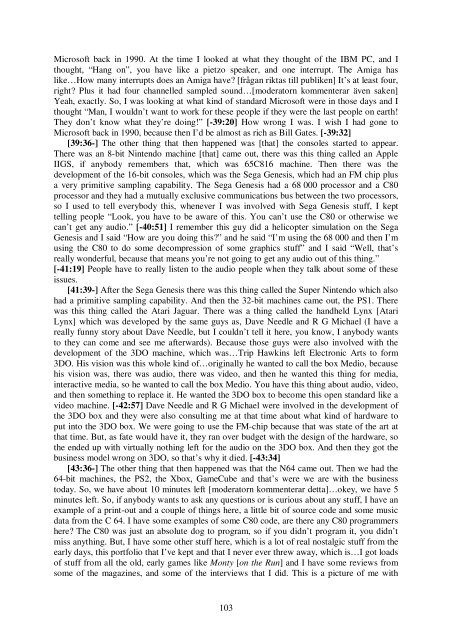Musikaliska uttryck och funktioner i interaktiva v rldar - C64.com
Musikaliska uttryck och funktioner i interaktiva v rldar - C64.com
Musikaliska uttryck och funktioner i interaktiva v rldar - C64.com
You also want an ePaper? Increase the reach of your titles
YUMPU automatically turns print PDFs into web optimized ePapers that Google loves.
Microsoft back in 1990. At the time I looked at what they thought of the IBM PC, and I<br />
thought, “Hang on”, you have like a pietzo speaker, and one interrupt. The Amiga has<br />
like…How many interrupts does an Amiga have? [frågan riktas till publiken] It’s at least four,<br />
right? Plus it had four channelled sampled sound…[moderatorn kommenterar även saken]<br />
Yeah, exactly. So, I was looking at what kind of standard Microsoft were in those days and I<br />
thought “Man, I wouldn’t want to work for these people if they were the last people on earth!<br />
They don’t know what they’re doing!” [-39:20] How wrong I was. I wish I had gone to<br />
Microsoft back in 1990, because then I’d be almost as rich as Bill Gates. [-39:32]<br />
[39:36-] The other thing that then happened was [that] the consoles started to appear.<br />
There was an 8-bit Nintendo machine [that] came out, there was this thing called an Apple<br />
IIGS, if anybody remembers that, which was 65C816 machine. Then there was the<br />
development of the 16-bit consoles, which was the Sega Genesis, which had an FM chip plus<br />
a very primitive sampling capability. The Sega Genesis had a 68 000 processor and a C80<br />
processor and they had a mutually exclusive communications bus between the two processors,<br />
so I used to tell everybody this, whenever I was involved with Sega Genesis stuff, I kept<br />
telling people “Look, you have to be aware of this. You can’t use the C80 or otherwise we<br />
can’t get any audio.” [-40:51] I remember this guy did a helicopter simulation on the Sega<br />
Genesis and I said “How are you doing this?” and he said “I’m using the 68 000 and then I’m<br />
using the C80 to do some decompression of some graphics stuff” and I said “Well, that’s<br />
really wonderful, because that means you’re not going to get any audio out of this thing.”<br />
[-41:19] People have to really listen to the audio people when they talk about some of these<br />
issues.<br />
[41:39-] After the Sega Genesis there was this thing called the Super Nintendo which also<br />
had a primitive sampling capability. And then the 32-bit machines came out, the PS1. There<br />
was this thing called the Atari Jaguar. There was a thing called the handheld Lynx [Atari<br />
Lynx] which was developed by the same guys as, Dave Needle and R G Michael (I have a<br />
really funny story about Dave Needle, but I couldn’t tell it here, you know, I anybody wants<br />
to they can come and see me afterwards). Because those guys were also involved with the<br />
development of the 3DO machine, which was…Trip Hawkins left Electronic Arts to form<br />
3DO. His vision was this whole kind of…originally he wanted to call the box Medio, because<br />
his vision was, there was audio, there was video, and then he wanted this thing for media,<br />
interactive media, so he wanted to call the box Medio. You have this thing about audio, video,<br />
and then something to replace it. He wanted the 3DO box to become this open standard like a<br />
video machine. [-42:57] Dave Needle and R G Michael were involved in the development of<br />
the 3DO box and they were also consulting me at that time about what kind of hardware to<br />
put into the 3DO box. We were going to use the FM-chip because that was state of the art at<br />
that time. But, as fate would have it, they ran over budget with the design of the hardware, so<br />
the ended up with virtually nothing left for the audio on the 3DO box. And then they got the<br />
business model wrong on 3DO, so that’s why it died. [-43:34]<br />
[43:36-] The other thing that then happened was that the N64 came out. Then we had the<br />
64-bit machines, the PS2, the Xbox, GameCube and that’s were we are with the business<br />
today. So, we have about 10 minutes left [moderatorn kommenterar detta]…okey, we have 5<br />
minutes left. So, if anybody wants to ask any questions or is curious about any stuff, I have an<br />
example of a print-out and a couple of things here, a little bit of source code and some music<br />
data from the C 64. I have some examples of some C80 code, are there any C80 programmers<br />
here? The C80 was just an absolute dog to program, so if you didn’t program it, you didn’t<br />
miss anything. But, I have some other stuff here, which is a lot of real nostalgic stuff from the<br />
early days, this portfolio that I’ve kept and that I never ever threw away, which is…I got loads<br />
of stuff from all the old, early games like Monty [on the Run] and I have some reviews from<br />
some of the magazines, and some of the interviews that I did. This is a picture of me with<br />
103


